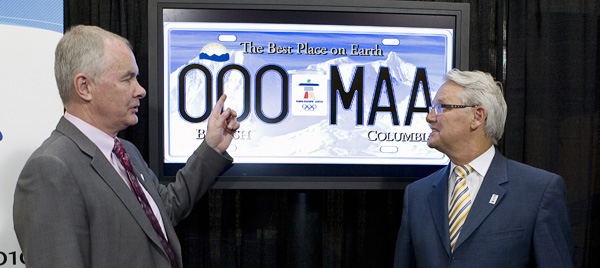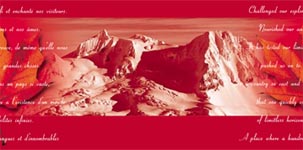On
April 11, 2007, and after months of anticipation,
British Columbia Premier Gordon Campbell, Solicitor
General John Les, ICBC President and CEO Paul
Taylor and Vancouver Olympic Committee (VANOC)
CEO John Furlong unveiled a new special issue
BC license plate to promote the staging of the
2010 Winter Olympic Games in Vancouver.
|
 Premier
Gordon Campbell (right) was joined by VANOC CEO
John Furlong (left)
Premier
Gordon Campbell (right) was joined by VANOC CEO
John Furlong (left)
to unveil the new B.C. licence plate celebrating
the 2010 Olympic and Paralympic Winter Games. |
Announced
at the head office of the Insurance Corporation
of British Columbia (ICBC) in North Vancouver, the
Premier symbolically attached the first plate of
the series, MAA-000 (pictured below) to a new GM
Vanoc Saturn Vue hybrid SUV (a vehicle which will
form part of the fleet of 4,500 GM vehicles used
during the Games). |
|
|
|
|
| Canadian
Olympic athletes Alexa Loo (L) and Sonja Gaudet
(R) look on as Gordon Campbell and John Furlong
officially unveil the 2010 Winter Games licence
plate and attach it to one of the hybrid vehicles
that is to form the official fleet for the
Games
|
|
From
left: John Furlong; Paul Taylor; Premier Gordon
Campbell; Alexa Loo; John Les; North Vancouver-Lonsdale
MLA Katherine Whittred; Sonja Gaudet; and
West Vancouver-Garibaldi MLA Joan McIntyre. |
|
Available
to motorists from April 16, 2007, the Olympic plates
feature Mount Garibaldi, which can be seen from
Highway 99 (13km north of Squamish) as one travels
from Vancouver to Whistler. According to ICBC, “the
chosen plate design captures the spirit of the Games
while showcasing one of the most scenic and breathtaking
areas between Vancouver and Whistler. The image
was also used in the Vancouver 2010 Olympic and
Paralympic Bid proposal." |
When
compared against the cover to the official Vancouver
Bid proposal, the image of Garibaldi is, in deed,
essentially the same. As has since been point out to us here at BCpl8s.ca, the image of Garibaldi on the bid cover is the inverted one, while the version on the license plate is correct. While not confirmed by ICBC,
it is suspected that the use of the correct version of the photo was done in order to prevent
the distinctive peak of Garibaldi from being concealed
beneath the new government logo - which has been included
at the top left of the plate. |

Bid proposal cover |

Passenger plate |
|
A
corollary to this new logo has been the banishment
of the traditional “Beautiful” slogan,
which has been used on passenger plates since 1964,
in favour of “The Best Place on Earth”
slogan recently adopted with much enthusiasm by
the ruling Liberal party in its efforts to “re-brand”
British Columbia. Although this change is not all
that ground-breaking as the Veteran’s plates
issued in 2004 contained no particular slogan, it
does raise a question as to the consistency of messages
that are being conveyed by the Province’s
passenger plates – are we merely beautiful,
or truly the best place on earth? Despite this conundrum,
ICBC has advised that, at this time, there are no
plans to adopt “The Best Place on Earth”
slogan on any other plates. |
Another
new design feature is the presence of two debossed
decal boxes at the bottom middle of the plate to
be used in the application of BC’s two registration
decals. Day decals are now to be applied to the
left and month/year decals to the right (please
see image below).
|
|
It
is thought that this was prompted by the location
of the Winter Games logo in the middle of the plate
and with an eye to the problems encountered with
the Veteran plates and the lack of a clearly identifiable
location in which to apply the day decals (which
has lead to a certain degree of day decal mayhem
on the vehicles of our former service men and women). |
| The Olympic
base will be made available to a wide range of vehicle
types including motor homes; commercial trucks; motorcycles;
utility trailers; commercial trailers; and farm trucks.
ICBC is advising that existing plate numbering conventions
will continue to apply to these plates, and that the
first plate in each series will be as follows (and
includes Farm Trucks starting at G9-0000): |
The extent
of the run for each vehicle type will ultimately
be determined by demand and, to this end, in announcing
the release of the plate ICBC CEO Paul Taylor suggested
that the company's market research indicates that
some 80,000 to 100,000 of the 2.2 million registered
motorists in British Columbia will be interested
in buying the plates. This research was conducted
by Ipsos-Reid, who surveyed over 1,200 ICBC customers
and found that 53% (or approximately 106,000 households)
expressed interest in obtaining 2010 Winter Games
licence plates. |

Passenger |

Motorcycle |

Truck |
|
Knowing
that the Passenger base is to be issued in the same
sequence as the Veteran base, as opposed to the
more convoluted sequence associated with the standard
“Flag Graphic” passenger base (i.e.
999-MAK is to be followed by 000-MAL, whereas under
the Flag Graphic 999-MAK would normally be followed
by 000-MBA) certain assumptions can be made. Using
ICBC’s research it can be deduced that the
passenger run could possibly progress into the 000-MFA
range, subject to demand. |
This
would leave a significant amount of un-used serials
(approximately 280,000) following the cessation
of the run in 2010. With the current Flag Graphic
serial only expected to last until 2015 (unless
a new base is introduced prior to this date), it
will be interesting to see what is done with the
remaining serials from this base. |
As
mentioned above, the series is only to be issued
through December 31, 2010, with motorists able to
renew their plates through December 31, 2012, after
which time they will have to be surrendered. It
is thought that this sunset clause on the plates
is related to ICBC’s six year, $15 million
sponsorship agreement with VANOC that designates
the provincial insurer as an Official Supporter
of the 2010 Winter Games. After this date, it is
assumed that the right to use the Olympic logo ceases
and, therefore, the right to collect fees associated
with it (i.e. from the renewal of plates bearing
the Olympic logo) ceases. |
Much
was made by the local press regarding the optics
of a crown corporation with a dominant position
in the auto insurance field pledging $15 million
to VANOC after having recently raised rates by 3.3%,
as well as whether this was simply a backdoor through
which the provincial government could funnel addition
supporting funds to VANOC. In response, ICBC has
stated that the business case for the agreement
was sound with $6 million to be provided through
in-kind services, such as the insuring of the fleet,
while the remaining $9 million is to be raised through
the sale and renewal of the license plates which
sell for a $35 fee (and annual renewal cost of $25).
|
Of
interest to Canadian motorists not living in British
Columbia but nevertheless wishing to share in our
festivities may be the comment from John Furlong
that VANOC will now be looking to partner with other
province's "to develop additional licence plate
programs in provinces and territories across Canada.”
While this is not uncommon in America or Australia
where individual states occasionally issue some
sort of special plate in support of their athlete’s
participation in whichever Games happens to be coming
up next, I am not sure how enthusiastic motorists
in Quebec or Newfoundland will be to send their
money to lotus land?
|
The
new Winter Games plate also joins a tradition started
by Quebec in 1976 and continued by Alberta in 1988
of Canadian jurisdictions hosting an Olympic Games
to issue some form of special license plate. For
comparison purposes, an image of the plate issued
by Utah for the last Winter Games held in North
America is also shown below. |

Montreal (1976) |

Calgary (1988) |

Salt Lake City (2002) |
.jpg)
Vancouver (2010) |
|